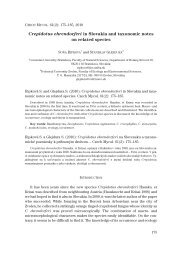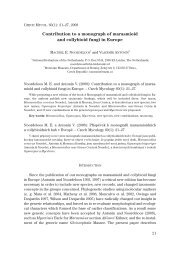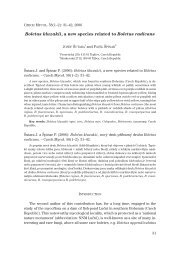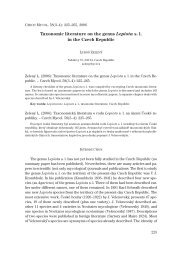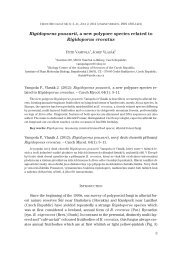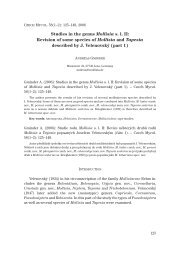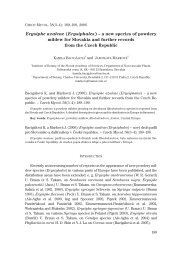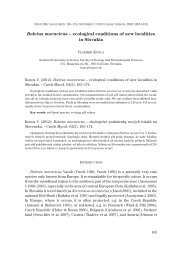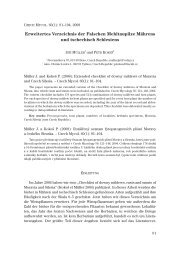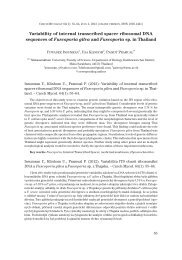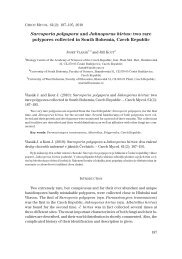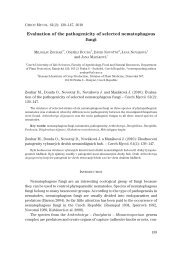Fungal melanonychia caused by Onychocola canadensis - CZECH ...
Fungal melanonychia caused by Onychocola canadensis - CZECH ...
Fungal melanonychia caused by Onychocola canadensis - CZECH ...
Create successful ePaper yourself
Turn your PDF publications into a flip-book with our unique Google optimized e-Paper software.
<strong>CZECH</strong> MYCOL. 63(1): 83–91, 2011<br />
<strong>Fungal</strong> <strong>melanonychia</strong> <strong>caused</strong> <strong>by</strong> <strong>Onychocola</strong> <strong>canadensis</strong>:<br />
first records of nail infections due to <strong>Onychocola</strong><br />
in the Czech Republic<br />
DAVID STUCHLÍK 1 , KAREL MENCL 2 , VÍT HUBKA 3* , MAGDALENA SKOŘEPOVÁ 4<br />
1 Regional Hospital Pardubice, Department of Dermatology, Czech Republic<br />
2 Regional Hospital Pardubice, Department of Clinical Microbiology, Czech Republic<br />
3 Charles University in Prague, Faculty of Science, Department of Botany, Benátska 2,<br />
128 01 Praha 2, Czech Republic;<br />
vit.hubka@seznam.cz<br />
4 Charles University in Prague, First Faculty of Medicine, Dermatological Clinic, Czech Republic<br />
*corresponding author<br />
Stuchlík D., Mencl K., Hubka V., Skořepová M. (2011): <strong>Fungal</strong> <strong>melanonychia</strong><br />
<strong>caused</strong> <strong>by</strong> <strong>Onychocola</strong> <strong>canadensis</strong>: first records of nail infections due to<br />
<strong>Onychocola</strong> in the Czech Republic. – Czech Mycol. 63(1): 83–91.<br />
<strong>Onychocola</strong> <strong>canadensis</strong> is a non-dermatophyte filamentous fungus with an unusual ecology. Hitherto,<br />
O. <strong>canadensis</strong> has been isolated only from human nails and skin, although attempts to isolate it<br />
from the environment have been unsuccessful. We describe two new cases of onychomycosis <strong>caused</strong><br />
<strong>by</strong> O. <strong>canadensis</strong> with dissimilar clinical appearance. The first infection manifested itself as distal and<br />
lateral onycholysis with conspicuous black pigmentation. As far as we know, this is the first description<br />
of O. <strong>canadensis</strong> onychomycosis in the Czech Republic. In connection with this case, the authors<br />
emphasise the importance of mycological laboratory examination of dark nail lesions. Based on photodocumentation,<br />
a second case of onychomycosis due to O. <strong>canadensis</strong> was identified retrospectively.<br />
This case manifested itself as distal and lateral subungual onychomycosis with yellow discoloration,<br />
which is more typical of O. <strong>canadensis</strong> onychomycosis. Morphological characteristics important for<br />
discrimination of O. <strong>canadensis</strong> from other medically important fungi are discussed.<br />
Key words: onychomycosis, Arachnomyces nodosetosus, fungal infection, elderly people, soil fungi.<br />
Stuchlík D., Mencl K., Hubka V., Skořepová M. (2011): Onychomykóza způsobená<br />
houbou <strong>Onychocola</strong> <strong>canadensis</strong>: nové případy infekce nehtů vlivem hou<strong>by</strong> rodu<br />
<strong>Onychocola</strong> v České republice. – Czech Mycol. 63(1): 83–91.<br />
<strong>Onychocola</strong> <strong>canadensis</strong> je nedermatofytická vláknitá houba s neobvyklou ekologií. Dosud <strong>by</strong>la<br />
O. <strong>canadensis</strong> izolována pouze z lidských nehtů a kůže. Pokusy o izolaci hou<strong>by</strong> z jiných substrátů <strong>by</strong>ly<br />
neúspěšné. V následujícím textu popisujeme dva nové případy onychomykózy způsobené O. <strong>canadensis</strong><br />
s rozdílnými klinickými projevy. První případ se manifestoval jako distální a laterální onycholýza<br />
s nápadně černou diskolorací. V souvislosti s tímto případem autoři zdůrazňují důležitost mykologického<br />
vyšetření tmavě zbarvených nehtových lézí. Pokud víme, je tento případ vůbec prvním případem<br />
onychomykózy způsobené O. <strong>canadensis</strong> v České republice. Druhý případ onychomykózy způsobené<br />
O. <strong>canadensis</strong> <strong>by</strong>l zpětně identifikován na základě fotodokumentace. Postižený nehet se manifestoval<br />
jako distální a laterální subunguální onychomykóza se žlutou diskolorací. Tento fenotyp je více<br />
příznačný pro onychomykózu způsobenou O. <strong>canadensis</strong>. Dále jsou diskutovány morfologické znaky<br />
důležité pro odlišení O. <strong>canadensis</strong> od jiných lékařsky významných hub.<br />
83
<strong>CZECH</strong> MYCOL. 63(1): 83–91, 2011<br />
INTRODUCTION<br />
<strong>Onychocola</strong> <strong>canadensis</strong> is a non-dermatophyte agent of onychomycosis. It is<br />
a relatively new species of fungus that occurs mainly in temperate climates and is<br />
probably associated with soil. This fungus was described based on three isolates<br />
from Canadian cases of onychomycosis (Sigler & Congly 1990). Since then, cases<br />
in New Zealand (Sigler et al. 1994), France (Contet-Audonneau et al. 1997, Koenig<br />
et al. 1997), Great Britain (Campbell et al. 1997, O´Donoghue et al. 2003), Italy<br />
(Fanti et al. 2003), Belgium (Esbroeck et al. 2003, Sijs et al. 2007) and Spain<br />
(Torres-Sangiao et al. 2006) have been reported. Recently, four cases were reported<br />
from Slovakia (Volleková & Lisalová 2009). It typically affects elderly gardeners<br />
and farmers. The mean age of patients in the previously described cases is<br />
almost 70. Most of the cases are described as distal and lateral subungual<br />
onychomycosis or white superficial onychomycosis similar to the appearance<br />
that might be expected with dermatophytes or other non-dermatophyte moulds<br />
such as Acremonium spp. Association with <strong>melanonychia</strong> has as yet been mentioned<br />
only in a case described <strong>by</strong> Gupta et al. (1998).<br />
The description of Arachnomyces nodosetosus – teleomorphic stage of<br />
O. <strong>canadensis</strong> (Sigler et al. 1994) was followed <strong>by</strong> several taxonomical studies focused<br />
on the position of the genus Arachnomyces and its anamorph <strong>Onychocola</strong><br />
(5 species described to date) within the Ascomycota (Gibas et al. 2002a, Gibas et<br />
al. 2002b, Gibas et al. 2004). It resulted in the creation of the new order<br />
Arachnomycetales within the Eurotiomycetes and description of several new species<br />
of the genus Arachnomyces. Except of A. nodosetosus, there are reports<br />
about several cases of isolation of three other Arachnomyces species and<br />
O. sclerotica (teleomorph not described) from nails or skin generally of unclear<br />
etiological significance (Sigler et al. 1994, Gibas et al. 2002a, Gibas et al. 2002b,<br />
Gibas et al. 2004).<br />
MATERIAL AND METHODS<br />
P a t i e n t 1. A 51-year-old woman diagnosed with onychodystrophy and black<br />
discoloration of the right great toenail of several years’ duration (Fig. 1B). She reported<br />
no recent progression of the lesion. Due to the long time lapse she could<br />
not recall the circumstances that led to the development of the lesion. She recalled<br />
no major trauma of the nail but minor repeated traumatisation of the distal<br />
nail plate could not be excluded. There was no history of foreign travels except<br />
for a holiday in Spain in summer 1997. She used to work in her garden. The family<br />
history and personal history of the patient were insignificant.<br />
84
STUCHLÍK D., MENCL K., HUBKA V., SKOŘEPOVÁ M.: ONYCHOCOLA CANADENSIS<br />
The toenail showed partial onycholysis, the affected part was thickened and<br />
dystrophic. Conspicuous black discoloration was present (Fig. 1B). Because of<br />
<strong>melanonychia</strong> it was crucial to exclude subungual melanoma. Another differential<br />
diagnosis was subungual haematoma.<br />
P a t i e n t 2. The second patient was an otherwise healthy 68-year-old woman.<br />
The patient described progressive discoloration of the left great toenail during the<br />
last year. She reported that she often took part in all-day hiking trips. She remembered<br />
a trauma of the nail due to tight shoes a year ago. A short time after the<br />
trauma, slight discoloration appeared. No history of foreign travels was reported.<br />
The affected nail was raised <strong>by</strong> hyperkeratosis, friable at the distal border, and<br />
demonstrated yellow discoloration (Figs. 1G, H).<br />
L a b o r a t o r y i n v e s t i g a t i o n s. Specimens for mycological examination<br />
(KOH mount and cultivation) were collected <strong>by</strong> scraping off the nail plate and observed<br />
microscopically in 20 % KOH. Nail fragments were inoculated on slants of<br />
Sabouraud glucose agar (SGA) with and without chloramphenicol (Bio-Rad) and<br />
incubated at 27 °C.<br />
The macromorphology of the subcultures was observed on a set of media (the<br />
producer of the commercial media is referred to in parenthesis, all other media<br />
were prepared according to Atlas 1997): MEA (malt extract agar, Oxoid), SGA<br />
(Carl Roth), PDA (potato dextrose agar), OA (oatmeal agar), CY20S (Czapek yeast<br />
extract sucrose 20 % agar), CDA (Czapek dox agar), PCA (potato carrot agar) and<br />
SNA (Synthetic nutrient agar). Cultures grew at a temperature of 25 °C. Growth at<br />
a temperature of 37 °C was also tested.<br />
Lactophenol cotton blue wet mount preparations from subcultures growing at<br />
25 °C were prepared at weekly intervals for a period of 8 weeks. Photographs<br />
were taken on an Olympus BX-51 microscope using Nomarski contrast or phase<br />
contrast.<br />
D N A a n a l y s i s. Genomic DNA was isolated from 14-day-old cultures using<br />
the Microbial DNA Isolation Kit (MoBio Laboratories, Inc.). The region including<br />
ITS1, 5.8S r DNA and ITS2 was amplified using primers ITS5 (White et al. 1990)<br />
and ITS4S (Kretzer et al. 1996). The SSU rDNA was amplified using the NS1<br />
(White et al. 1990) and NS24 (Gargas & Taylor 1992) primer set. A partial sequence<br />
of LSU rDNA was amplified with the NL1 (O’Donnell 1993) and LR6 (Vilgalys &<br />
Hester 1990) primer sets. PCR amplification was performed using the same cycling<br />
conditions for all three rDNA regions and followed procedures described in<br />
Kolařík et al. (2004). PCR product purification and sequencing was carried out at<br />
Macrogen Inc. (Seoul, South Korea). Using BLAST similarity search, the obtained<br />
sequences were compared with sequences originating from taxonomical monographs<br />
deposited on the GenBank server.<br />
85
<strong>CZECH</strong> MYCOL. 63(1): 83–91, 2011<br />
RESULTS<br />
Laboratory investigations<br />
Microscopic examination of the nail scrapings in KOH showed septate<br />
branched hyphae and masses of arthroconidia (Figs. 1A, C, F). In both mentioned<br />
cases slow growth of a pure culture of a non-dermatophyte hyphomycete was observed<br />
on SGA with chloramphenicol (Figs. 1D, E). After 3 weeks at 27 °C the colonies<br />
were restricted, initially greyish white but gradually darkening. The colony<br />
reverse was dark grey-brown to black. After 6 weeks the colonies in the prime culture<br />
were almost brown-black. This pigmentation was less accented in the subcultures.<br />
The same fungus was isolated and observed in direct microscopy during<br />
a subsequent visit.<br />
Therapy<br />
In case 1, an ointment containing 40 % urea without antifungals was applied for<br />
atraumatic nail avulsion. When the patient returned after 3 weeks for<br />
debridement of the softened nail plate, and a third specimen was collected from<br />
the subungual debris. The same fungus grew again in pure culture. The epidermis<br />
of the nail bed showed no melanin pigmentation so that subungual melanoma and<br />
haematoma could be excluded. Topical antifungal therapy with a 1 % ciclopirox<br />
solution was applied and the diseased nail grew out gradually. After nine months<br />
of therapy, clinical appearance of the nail was normal and mycological control<br />
was negative.<br />
In the second case, a daily oral dose of terbinafine (250 mg) was administered<br />
for three months. After 10 months, the nail plates exhibited healthy growth. Mycological<br />
examination was negative.<br />
Macro– and micromorphology of subcultures<br />
Growth on all tested media was slow. Colony diameters reached about 10 mm<br />
or less after 3 weeks at 25 °C. Growth was even more restricted at 37 °C. On MEA<br />
(Fig. 2C), SAB (Fig. 1E) and PDA (Fig. 2B), the colonies were initially glabrous<br />
and became velvety or tomentose after 2 weeks due to aerial hyphae that grew on<br />
surface of the colonies. The margin of the colonies was irregularly lobate and the<br />
height of the colonies increased. They became conical and radially wrinkled. The<br />
colour was white, grey-white or yellow-white, old colonies acquired a brownish<br />
colour through brown hyphae that had appeared in culture after some weeks. The<br />
colour of the reverse was brownish and became dark-brown after some weeks.<br />
Submerged mycelium with radial arrangement was a dominant component on nutrient-weak<br />
media (PCA, SNA) and CDA. Colonies on OA showed yeast-like<br />
86
STUCHLÍK D., MENCL K., HUBKA V., SKOŘEPOVÁ M.: ONYCHOCOLA CANADENSIS<br />
Fig. 1. Onychomycosis <strong>by</strong> <strong>Onychocola</strong> <strong>canadensis</strong>. Distal and lateral onycholysis with dark discoloration<br />
of the nail (B). Colonies on slants of SGA (D) and on an SGA plate after 21 days (E, scale bar 5 mm).<br />
Septate hyphae and arthroconidia in nail debris. KOH mount stained with Parker ink (A, C, F). Affected<br />
nail (case 2) raised <strong>by</strong> hyperkeratosis, friable at the distal border, with yellow discoloration (G, H).<br />
growth and remained glabrous. The most abundant aerial mycelium was developed<br />
on CY20S (Fig. 2D).<br />
Micromorphological features were described from MEA, SGA and PDA, on<br />
which essentially the same image was observed and all typical morphological<br />
characters were well developed. At first, the young vegetative hyphae were<br />
smooth, hyaline and up to 2.5 μm wide. Finally, they became roughly verrucose<br />
(Fig. 2E). Fertile hyphae were poorly differentiated from vegetative mycelium.<br />
87
<strong>CZECH</strong> MYCOL. 63(1): 83–91, 2011<br />
Fig. 2. <strong>Onychocola</strong> <strong>canadensis</strong>. Fertile hyphae consisting of elliptic arthroconidia seceded <strong>by</strong> fracture<br />
(A, F, scale bar 20 μm). Hyaline, rough-walled hyphae (E, scale bar 10 μm) and pigmented hyphae with<br />
dark brown nodosities (G, scale bar 10 μm). Colony detail on PDA (B), MEA (C) and CY20S (D) after<br />
five weeks at 25 °C; scale bar 5 mm.<br />
Arthroconidia were profusely present in culture after 3–4 weeks of cultivation.<br />
They were hyaline, smooth and ellipsoidal with 1 septum or non-septate (Fig. 2A,<br />
F). Conidia were released intercalarily or terminally due to constriction of the<br />
septum or due to rhexolysis. They often persisted in chains. Brown, infrequently<br />
septate hyphae (up to 6 μm wide) were present mainly in old cultures (Fig. 2G).<br />
Dark brown nodosities occurred abundantly on their walls.<br />
88
STUCHLÍK D., MENCL K., HUBKA V., SKOŘEPOVÁ M.: ONYCHOCOLA CANADENSIS<br />
The case 1 isolate is maintained in the Culture Collection of Fungi (CCF), Department<br />
of Botany, Charles University in Prague, as CCF 3957. The case isolate<br />
from the second report was identified retrospectively. This identification was possible<br />
thanks to accurate photo-documentation of colony morphology and microscopic<br />
preparations of the isolate. However, we were not able to revive the isolate.<br />
Molecular data analysis<br />
The morphological identification was supported <strong>by</strong> rDNA sequence data. The<br />
sequence obtained from ITS region (602 bp) showed 100 % similarity to the type<br />
strain of A. nodosetosus UAMH 5344 (Gibas et al. 2004). The SSU rDNA sequence<br />
(814 bp) was 100 % similar to A. nodosetosus strain UAMH 6106 (Gibas et al.<br />
2002a). The partial LSU (798 bp) sequence was 100 % similar to A. nodosetosus<br />
strain CBS 313.90 (Sugiyama and Mikawa 2001).<br />
The sequences were deposited in the GenBank database under accession numbers<br />
HM205102–HM205104.<br />
DISCUSSION<br />
To our knowledge, isolation of O. <strong>canadensis</strong> has not yet been reported from<br />
the Czech Republic. Four cases have been recently reported from Slovakia<br />
(Volleková & Lisalová 2009).<br />
<strong>Onychocola</strong> <strong>canadensis</strong> is a fungus with an unusual ecology. Based on published<br />
data, O. <strong>canadensis</strong> has been isolated only from clinical material and has<br />
been reported from countries located in the temperate climate zone. However,<br />
there are some omissions in this distribution. In particular, O. <strong>canadensis</strong> has not<br />
been recorded from the USA.<br />
Onychomycosis due to O. <strong>canadensis</strong> manifests itself mostly as distal and lateral<br />
onychomycosis or white superficial onychomycosis. Onychomycosis associated<br />
with brown-black nail discoloration (<strong>melanonychia</strong>, patient 1) is unusual and<br />
has been reported only in one case <strong>by</strong> Gupta et al. (1998). It is necessary to exclude<br />
subungual melanoma and subungual haematoma in a differential diagnosis.<br />
O. <strong>canadensis</strong> has been isolated more frequently in elderly females. The patients<br />
often worked as gardeners or farmers. This suggests probable infection from<br />
soil (Gupta et al. 1998). This is in agreement with two new reports presented here.<br />
A number of morphological features such as growth parameters, colony morphology<br />
and micromorphology make the fungus practically unmistakable. On the<br />
other hand, the rare isolation of O. <strong>canadensis</strong> (only dozens of cases worldwide<br />
so far) makes its determination nontrivial. The most important features in identifying<br />
the fungus are growth parameters, presence of elliptic arthroconidia in<br />
89
<strong>CZECH</strong> MYCOL. 63(1): 83–91, 2011<br />
chains together with rough vegetative hyphae and also brown hyphae with dark<br />
superficial deformities. All important micro-morphological features (including<br />
arthroconidial chains and brown hyphae) develop well in 4–6 week-old cultures.<br />
Examination of cultures older than 4 weeks growing on solid media such as SAB,<br />
MEA and PDA at 25 °C is likely to lead to a correct determination.<br />
The culture morphology and microscopic appearance before the third week of<br />
cultivation may imitate Trichophyton rubrum and this might cause misidentification.<br />
Conversely, atypical isolates of T. rubrum may resemble O. <strong>canadensis</strong> in<br />
some features. The occasionally cited report of onychomycosis <strong>caused</strong> <strong>by</strong> O.<br />
<strong>canadensis</strong> from Turkey (Erbagci et al. 2002) was revised <strong>by</strong> R.C. Summerbell and<br />
the strain was re-identified as atypical T. rubrum (Fanti et al. 2003). The possibility<br />
to mistake O. <strong>canadensis</strong> for Scytalidium, which can appear in our geographical<br />
latitude as an etiological agent of imported mycosis, was discussed <strong>by</strong> Sigler<br />
et al. (1990) and Volleková & Lisalová (2009).<br />
In summary, we have reported these two cases because O. <strong>canadensis</strong> is infrequently<br />
detected as a human pathogen and had not yet been reported from Czech<br />
Republic. Moreover, both cases showed strikingly different clinical appearance.<br />
Onychomycosis due to O. <strong>canadensis</strong> is characterised <strong>by</strong> chronicity and slowly<br />
progressing infection, and patients usually appear several months or years after<br />
its beginning. It is possible that <strong>Onychocola</strong> spp. are relatively common in<br />
dermato-mycological specimens but are overlooked due to their slow growth.<br />
ACKNOWLEDGEMENTS<br />
The project was realised thanks to grant MSM 6007665801. We thank the staff<br />
of the Laboratory of Genetics, Physiology and Bioengineering of Fungi, ASCR,<br />
v.v.i. for assistance with molecular analyses.<br />
REFERENCES<br />
ATLAS R. M. (1997): Handbook of microbiological media. Ed. 2. – 1079 p. Boca.<br />
CAMPBELL C. K., JOHNSON E. M, WARNOCK D. W. (1997): Nail infection <strong>caused</strong> <strong>by</strong> <strong>Onychocola</strong> <strong>canadensis</strong>:<br />
report of first four British cases. – J. Med. Vet. Mycol. 35: 423–425.<br />
CONTET-AUDONNEAU N., SCHMUTZ J. L., BASILE A. M., BIÈVRE C. (1997): A new agent of onychomycosis<br />
in elderly: <strong>Onychocola</strong> <strong>canadensis</strong>. – Eur. J. Dermatol. 7: 115–117.<br />
ERBAGCI Z., BALCI I., ERKILIÇ S., ZER Y., INCI R. (2002): Cutaneous hyalohyphomycosis and onychomycosis<br />
<strong>caused</strong> <strong>by</strong> <strong>Onychocola</strong> <strong>canadensis</strong>: report of the first case from Turkey. – J. Dermatol. 29:<br />
522–528.<br />
ESBROECK M., WUYTACK C., LOOVEREN K., SWINNE D. (2003): Isolation of <strong>Onychocola</strong> <strong>canadensis</strong> from<br />
four cases of onychomycosis in Belgium. – Acta Clin. Belg. 58: 190–192.<br />
90
STUCHLÍK D., MENCL K., HUBKA V., SKOŘEPOVÁ M.: ONYCHOCOLA CANADENSIS<br />
FANTI F., CONTI S., ZUCCHI A., POLONELLI L. (2003): First Italian report of onychomycosis <strong>caused</strong> <strong>by</strong><br />
<strong>Onychocola</strong> <strong>canadensis</strong>. – Med. Mycol. 41: 447–450.<br />
GARGAS A., TAYLOR J. W. (1992): Polymerase chain reaction (PCR) primers for amplifying and sequencing<br />
nuclear 18S rDNA from lichenized fungi. – Mycologia 84: 589–592.<br />
GIBAS C. F. C., SIGLER L., CURRAH R. S. (2004): Mating patterns and ITS sequences distinguish the sclerotial<br />
species Arachnomyces glareosus sp. nov. and <strong>Onychocola</strong> sclerotica. – Stud. Mycol. 50:<br />
525–531.<br />
GIBAS C. F. C., SIGLER L., SUMMERBELL R. C., CURRAH R. S. (2002a): Phylogeny of the genus Arachnomyces<br />
and its anamorphs and the establishment of Arachnomycetales, a new eurotiomycete order<br />
in the Ascomycota. – Stud. Mycol. 47: 131–139.<br />
GIBAS C. F. C., SIGLER L., SUMMERBELL R. C., HOFSTADER S. L. R., GUPTA A. K. (2002b): Arachnomyces<br />
kanei (anamorph <strong>Onychocola</strong> kanei) sp. nov., from human nails. – Med. Mycol. 40: 573–580.<br />
GUPTA A. K., HORGA-BELL C. B, SUMMERBELL R. C. (1998): Onychomycosis associated with <strong>Onychocola</strong><br />
<strong>canadensis</strong>: ten case reports and a review of the literature. – J. Am. Acad. Dermatol. 39: 410–417.<br />
KOENIG H., BALL C., BIÈVRE C. (1997): First European cases of onychomycosis <strong>caused</strong> <strong>by</strong> <strong>Onychocola</strong><br />
<strong>canadensis</strong>. – J. Med. Vet. Mycol. 35: 71–72.<br />
KOLAŘÍK M., KUBÁTOVÁ A., PAŽOUTOVÁ S., ŠRŮTKA P. (2004): Morphological and molecular characterisation<br />
of Geosmithia putterillii, G. pallida comb. nov. and G. flava sp. nov., associated with<br />
subcorticolous insects. – Mycol. Res. 108: 1053–1069.<br />
KRETZER A., LI Y., SZARO T., BRUNS T. D. (1996): Internal transcribed spacer sequences from 38 recognized<br />
species of Suillus sensu lato: phylogenetic and taxonomic implications. – Mycologia 88:<br />
776–785.<br />
O´DONNELL K. (1993): Fusarium and its relatives. –– In: Reynolds D. R, Taylor J. W., eds., The fungal<br />
holomorph: mitotic, meiotic, and pleomorphic speciation in fungal systematics, p. 225–233,<br />
Wallingford.<br />
O´DONOGHUE N. B., MOORE M. K, CREAMER D. (2003): Onychomycosis due to <strong>Onychocola</strong> <strong>canadensis</strong>.<br />
– Clin. Exp. Dermatol. 28: 283–284.<br />
SIGLER L., ABBOTT S. P., WOODGYER A. J. (1994): New records of nail and skin infection due to<br />
<strong>Onychocola</strong> <strong>canadensis</strong> and description of its teleomorph Arachnomyces nodosetosus sp. nov. –<br />
J. Med. Vet. Mycol. 32: 275–285.<br />
SIGLER L., CONGLY H. (1990): Toenail infection <strong>caused</strong> <strong>by</strong> <strong>Onychocola</strong> <strong>canadensis</strong> gen. et sp. nov. –<br />
J. Med. Vet. Mycol. 28: 405–417.<br />
SIJS A., TEMMERMAN L., WALLEGHEM L., MAREEN P. (2007): <strong>Onychocola</strong> <strong>canadensis</strong>: a rare cause of<br />
onychomycosis. – Tijdschr. Geneeskd. 63: 207–210.<br />
SUGIYAMA M., MIKAWA T. (2001): Phylogenetic analysis of the non-pathogenic genus Spiromastix<br />
(Onygenaceae) and related onygenalean taxa based on large subunit ribosomal DNA sequences. –<br />
Mycoscience 42: 413–421.<br />
TORRES-SANGIAO E., DURÁN-VALLEB M. T., VELASCO-FERNÁNDEZA D., VILLANUEVA-GONZÁLEZA R. (2006):<br />
Disto-lateral subungual onychomycosis in a 71-year-old woman. – Enfern. Infecc. Microbiol. Clin.<br />
24: 527–528. [in Spanish]<br />
VILGALYS R., HESTER M. (1990): Rapid genetic identification and mapping of enzymatically amplified ribosomal<br />
DNA from several Cryptococcus species. – J. Bacteriol. 172: 4238–4246.<br />
VOLLEKOVÁ A., LISALOVÁ M. (2009): <strong>Onychocola</strong> <strong>canadensis</strong>: first isolates from onychomycoses in<br />
Slovakia. – Epidemiol. Mikrobiol. Imunol. 58: 19–24. [in Slovak]<br />
WHITE T. J., BRUNS T., LEE S., TAYLOR J. (1990): Amplification and direct sequencing of fungal ribosomal<br />
RNA genes for phylogenetics. – In: Innis M. A., Gelfand D. H., Sninsky J. J, White T. J., eds., PCR<br />
protocols, a guide to methods and applications, p. 315–322, San Diego.<br />
91



